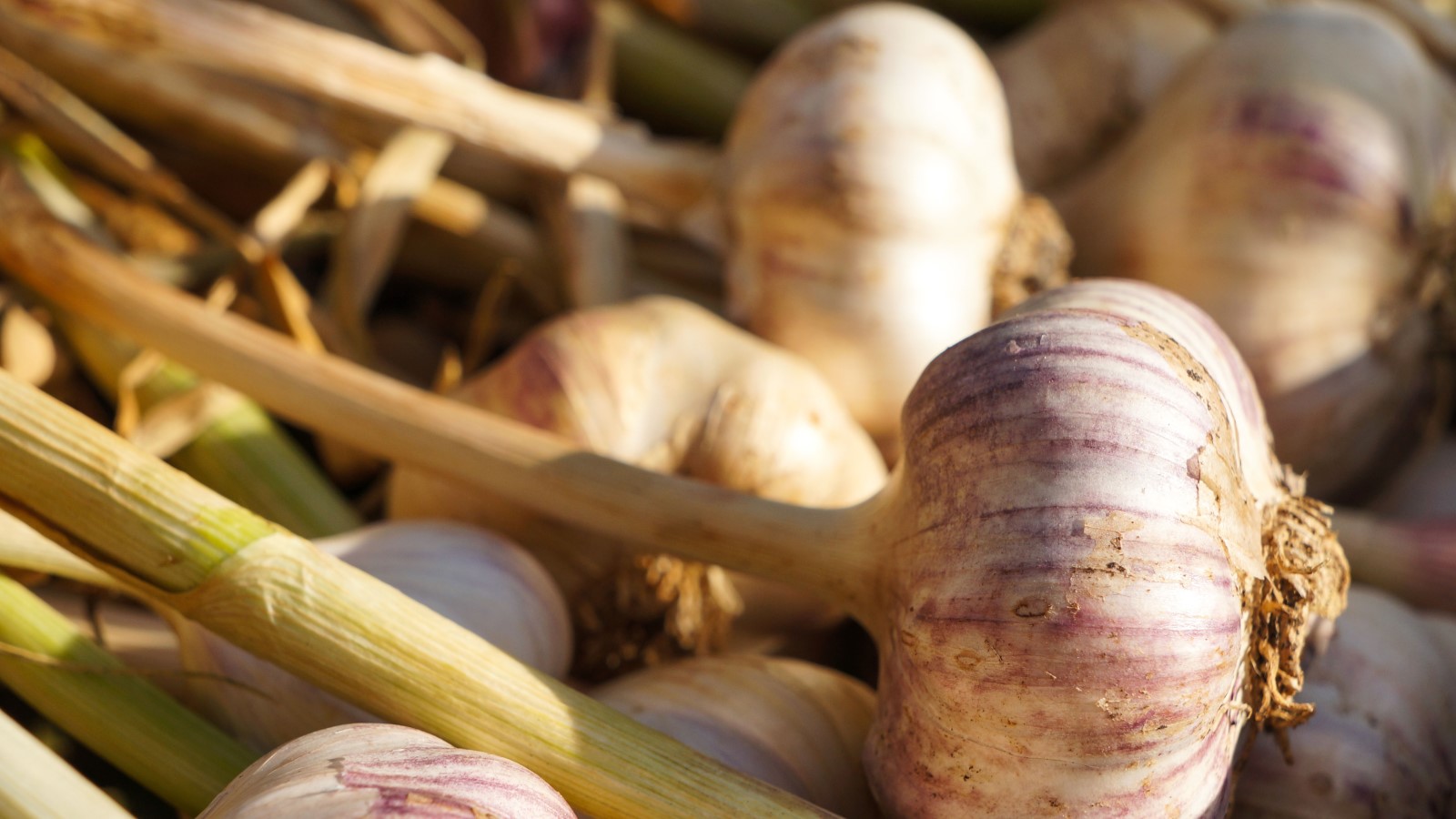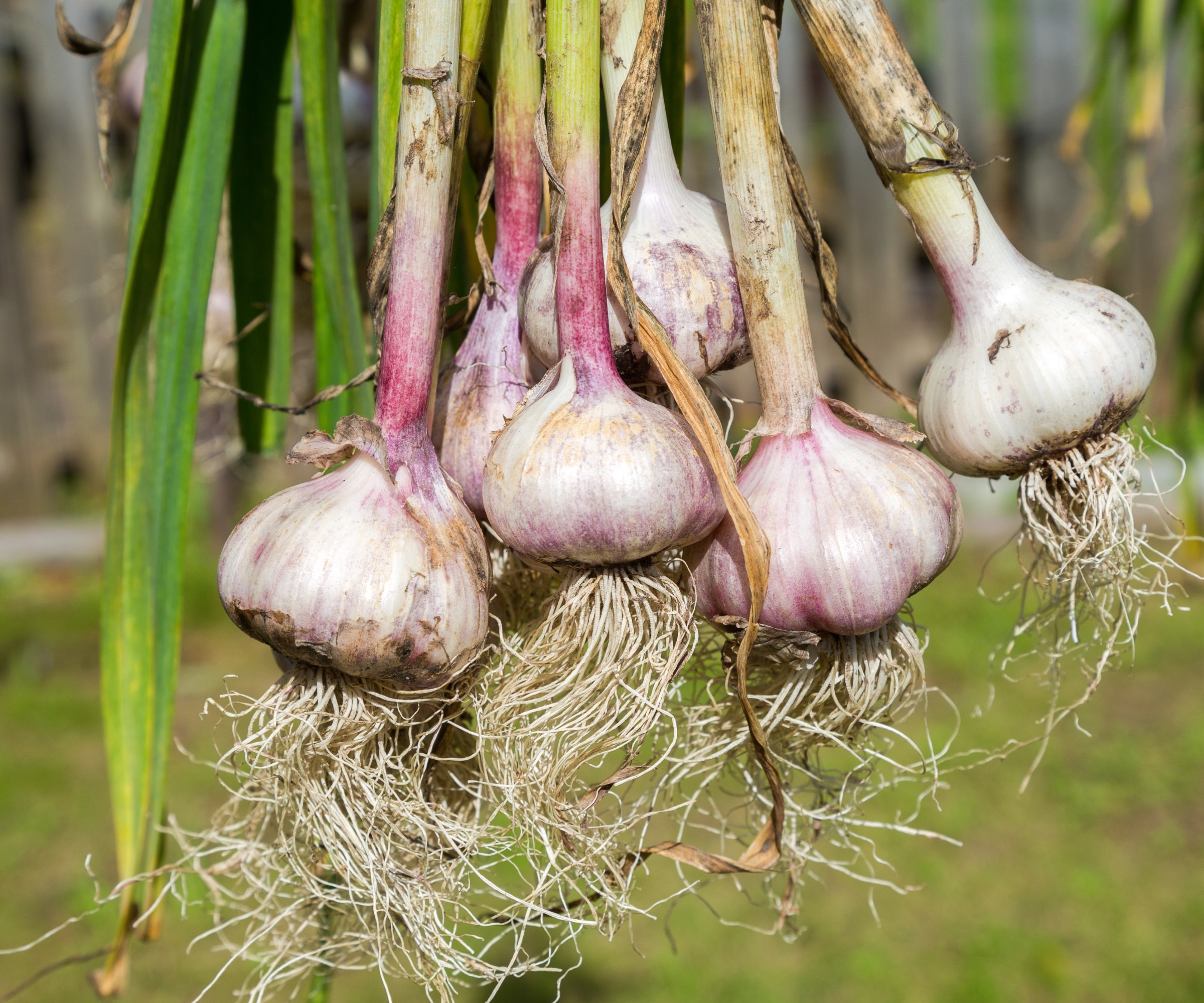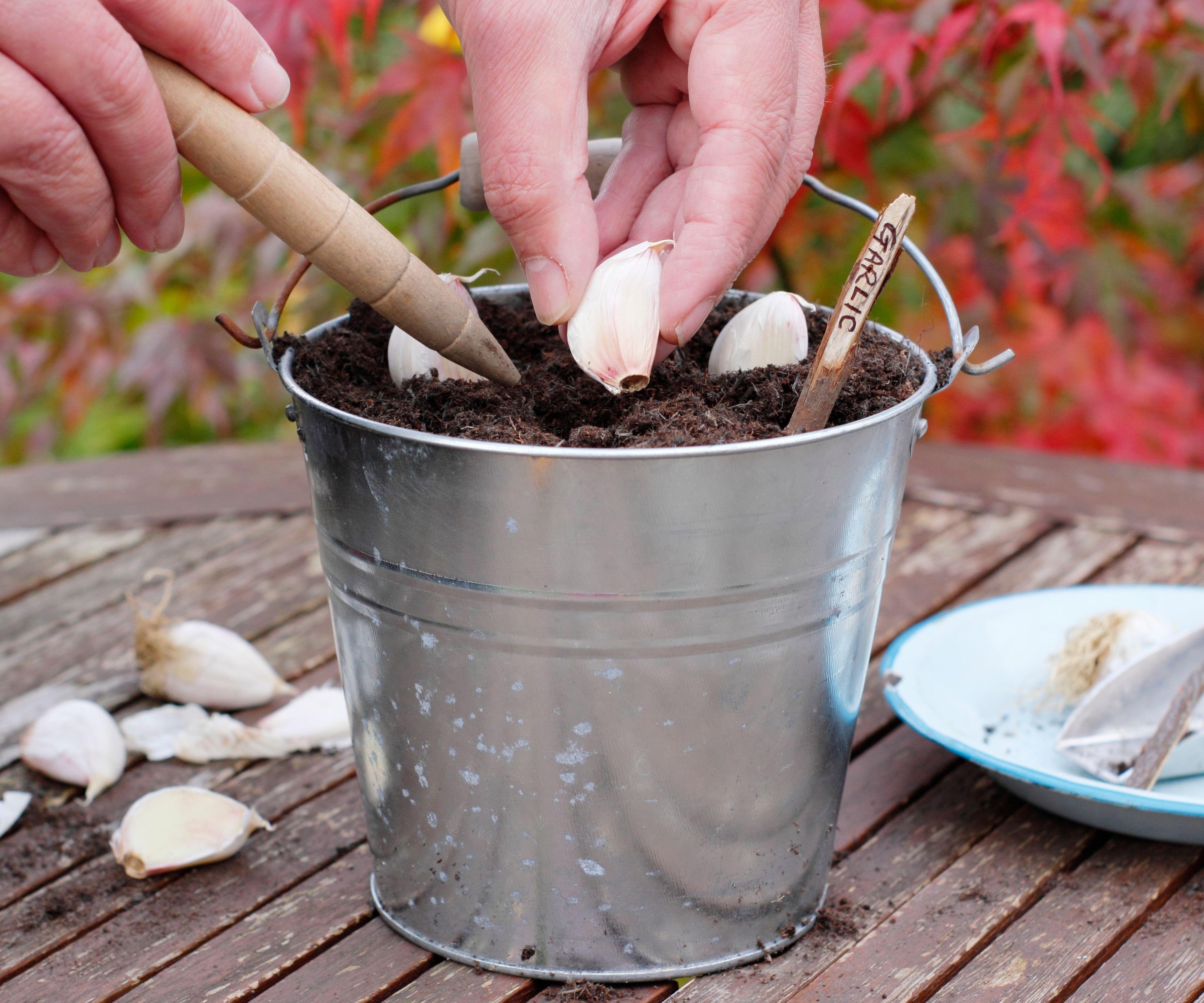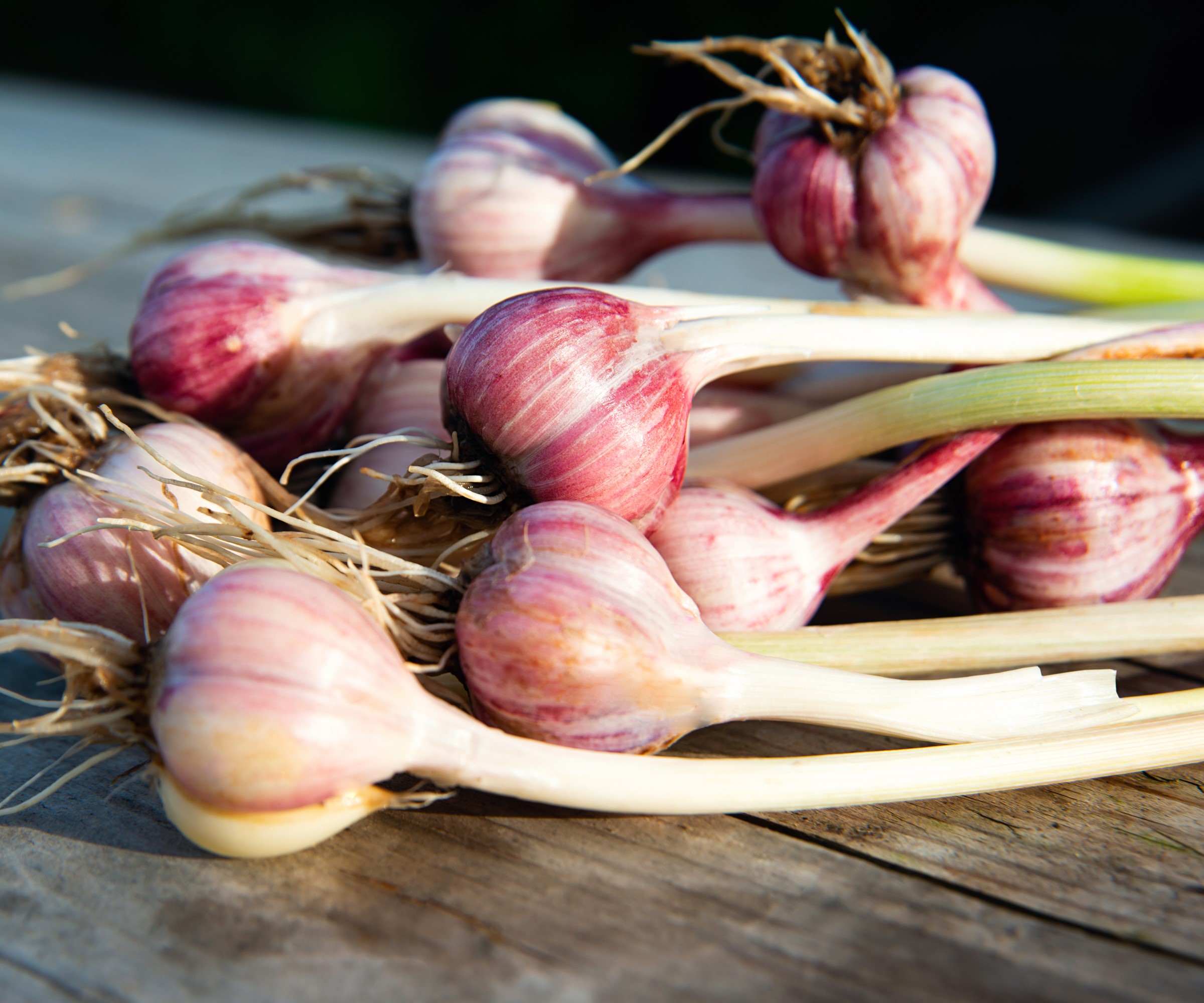How to grow garlic in pots – expert tips for a good crop
With our advice, anyone can appreciate the joys of growing garlic in containers – even if you don't have a large backyard


Growing garlic in pots is a great way of getting a crop when you do not have the room for vegetable beds full of edibles. The type of pot you choose, the soil you fill it with, and where you place the container can all contribute to a bountiful harvest.
Garlic is a highly popular crop to grow in pots and there is a huge range of types and varieties of bulbs available. Growing garlic in containers does require some extra thought and attention than growing it in the ground, however, it is still a simple crop to grow and really worthwhile.
Learning how to grow garlic at home in pots can mean an almost year-round access to homegrown garlic for all your culinary needs, as varieties can store for between a few months to a year.

Brush off at much soil as possible after harvesting garlic

Drew is a former professional gardener who specialized in growing vegetables and fruit. He worked in kitchen gardens for the National Trust in the UK and ran a productive historic walled garden growing vegetables, fruit, and herbs for a high-caliber restaurant in England.
Pros and cons of growing garlic in pots
The opportunity to grow garlic in pots means anyone is able to grow this kitchen garden favorite, no matter their location or space. It's a really simple container gardening idea, and your pots can be placed around a yard or even used to grow crops on a balcony.
You can engineer the best growing conditions for the crop too – something you cannot do to the same degree growing it in the ground. You can choose the ideal soil type and cherry-pick the location, even moving your outdoor planter around the yard to chase the sunniest spots.
It is also a good option for any growers that have had onion white rot on their plot. White rot is a serious fungal disease that can affect a crop and remain in the soil for many years afterwards. It prevents the growing of alliums such as garlic or onions in that ground for many years afterwards.
Garlic does have a very long growing season, however, and can take almost 10 months to go from planting to harvesting. That means that growing garlic in pots is a long-term commitment and will require a great deal of monitoring, watering and nurturing throughout the growing season. To guarantee a good crop of garlic you will also need multiple plants – that can potentially mean needing large and numerous containers.
Design expertise in your inbox – from inspiring decorating ideas and beautiful celebrity homes to practical gardening advice and shopping round-ups.
For anyone wanting to give it a go, good varieties to grow in pots include California Early and Early Italian, both available from Burpee. Siberian hardneck garlic, available from Amazon, is also a good option.

Garlic needs to be watered as it grows until a bulb is formed
How to grow garlic in pots in 7 easy steps
Cristian DeRusha, Farm Director at Arden, an agrihood community in South Florida, recommends that every decision is made to create ‘the best environment for your plants to succeed’. This includes choosing the type of pot and making an effort to protect the precious bulbs from the harshest weather conditions.
- Choose your container A large pot is required with a minimum depth of 8 inches. It must have good drainage to allow excess water to escape and needs to be large enough to allow 4 inches between cloves.
- Fill your pot with soil Choose a good-quality fertile compost that drains well. Add one-part organic matter or well-rotted manure to two-parts compost to enrich the soil. Considering adding a handful granular organic slow release fertilizer to the compost prior to planting.
- Plant your cloves Split heads of garlic into individual cloves. Pick the largest ones to plant. Press each one 3 inches deep into the soil with the pointy end facing upward. Space each clove around 4 inches apart to give them enough space to develop.
- Add a layer of mulch ‘Once your cloves are in the soil, water your pot and place a thick layer of mulch or straw on top,' recommends Cristian. 'This helps keep the garlic insulated through the winter. Another great way to keep your bulbs from freezing is to wrap your pot in bubble wrap.’ Consider mulching the surface again during the season to help keep moisture in the soil and protect the bulb from the elements.
- Location Place your container in a sunny spot, ideally where it will receive 6-8 hours of sun a day. When planting in winter, ensure the area doesn’t get too wet.
- Keep on top of watering Throughout the growing season, water regularly and keep it damp, but do not let the pot get too wet or water-logged. Too much moisture, combined with not enough sun, can lead to the build up of humidity in the pot and increase risk of disease.
- Inspect for weeds Keep the soil weed-free to reduce competition for water and nutrients.

Garlic cloves are separated from the bulb for planting
When to plant garlic in a container
The exact type of garlic you choose to grow in your pots will dictate the timing for when to plant garlic. There are two types of garlic, hardneck and softneck garlic. Hardneck varieties are much hardier than softneck ones and are planted in fall. They need a period of cold weather in order to grow and develop property, ideally up to two months at -40˚F. Softneck varieties will not tolerate really cold temperatures for prolonged periods and are planted anytime through to the early spring.
Garlic planted in spring will still grow, however bulbs may be smaller. There are some cultivars that are more suitable to plant in late winter or early spring.
As a rule, do not plant cloves of shop-bought garlic in your pots as they can either bring disease into a garden or some cloves can be chemically-treated to not sprout.

Be mindful not to plant the garlic cloves too deep
What are the best type of pots for growing garlic?
There are many options available when it comes to choosing a pot for growing garlic. Large pots or planters can come in different sizes and materials, including terracotta, plastic, ceramic or slate.
Cristian DeRusha, Farm Director at Arden, claims: ‘When you’re potting, ditch the terracotta pots and look at plastic or glazed ceramic containers, which are frost-proof and won’t crack when it gets cold.’
Plastic or glazed ceramic containers will not dry out as fast as unglazed terracotta pots tend to. Due to terracotta being a more porous material, it means a lot of air movement through the walls and that in turn dries the soil out quicker. This is not ideal for plants who like their soil to be damp. When you water plants in plastic containers, for example, there isn't such air movement, so the soil stays moist for longer.
As well as being more likely to crack or break outdoors in cold weather, as Cristian suggests, terracotta pots are also heavier to move around than their plastic counterparts and it is a lot more difficult to add extra drainage holes if required.

Garlic is lifted from early summer onwards
Do you need to use fertilizer when growing garlic in pots?
Garlic is a heavy feeder and its long season means it needs fertilizing. This is even more crucial when it is being grown in a container and can easily use up all the food available in the soil.
By adding good compost and additional fertilizer or well-rotted manure when planting, you give the plant a good start to life. However, it will need more in spring, especially if planted in the fall, so feed it with a high nitrogen fertilizer, such as natural bone meal fertilizer, available from Amazon, at least once a month until early summer.
How long does it take to grow garlic in pots?
When to harvest garlic will be dependent on your location and weather conditions. While garlic does not take any longer to develop in containers than when grown in the ground, there are some general signs to look out for to identify when a crop is ready.
As a rule, garlic planted in the fall will be ready in early summer, while those bulbs planted in spring are likely ready in early fall. A major tell-tale sign that garlic is ready is when the leaves turn yellow.

Drew has worked as a writer since 2008 and was also a professional gardener for many years. As a trained horticulturist, he worked in prestigious historic gardens, including Hanbury Hall and the world-famous Hidcote Manor Garden. He also spent time as a specialist kitchen gardener at Soho Farmhouse and Netherby Hall, where he grew vegetables, fruit, herbs, and cut flowers for restaurants. Drew has written for numerous print and online publications and is an allotment holder and garden blogger. He is shortlisted for the Digital Gardening Writer of the Year at the 2025 Garden Media Guild Awards.